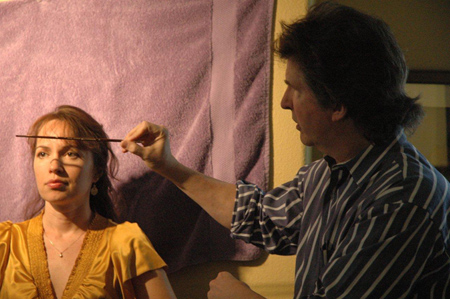|
MORE ABOUT THE THOMAS NASH PORTRAIT PAINTING WORKSHOPS
Portrait painting is Tom's specialty. He enjoys doing it and he enjoys teaching it.
Even if you do not aspire to become a professional portrait painter you will find that the ability to make your faces and figures more solid,
more realistic and more organic with better color will enhance all of your work that involves people. .

In this 2009 Portrait workshop in California, Tom demonstrates how to distinguish
dark halftone from shadow by using a brush handle to cast a shadow across the
models' face.
Tom's innovative ways of teaching.

For one of his studio classes, he build a PVC pipe "cage" around the model stand to
help his students visualize and understand how perspective played a role in how they
perceived the head and the figure even in a portrait situation.
Some Topics Covered:
- Understanding what the figure is doing.
- Understanding what the light is doing and how it affects what is seen.
- Characterization and Portraiture, what separates a Portrait from a "good head study"
- Salient points within the head and the keys to getting a likeness every time.
- Posing and lighting the model to best indicate what it is you wish to express about your subject
- Procedure to build your Portrait solidly, sensitively and accurately.
- The human form, anatomy, planes, volumes, seeing them, understanding them, painting them.
- Using form concepts to simplify your approach to the figure.
- The benefits and drawbacks of working from the inside out, or from an "envelope", or from a gesture.
- The role of memory in realistic painting.
- Keeping a fresh eye by asking yourself meaningful questions while working.
- How to be deadly accurate by using the right sequence of judgments.
- How what you see and what you know can and should complement each other.
- Recognizing problems before they get out of hand.
- Pit falls to avoid when judging light and shade.
- Useful perspective concepts that help you "read' your subject faster.
- Setting up the figure, what's important and what can wait?
- Enjoying painting more by constructing from knowledge.
- Painting on purpose, avoiding confusion.
Return To Portrait Workshop Information
|

